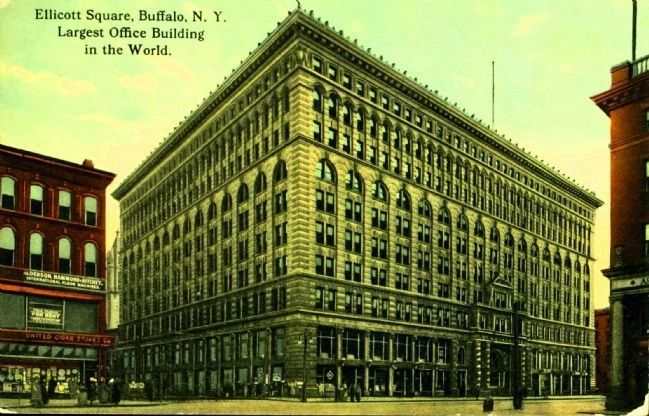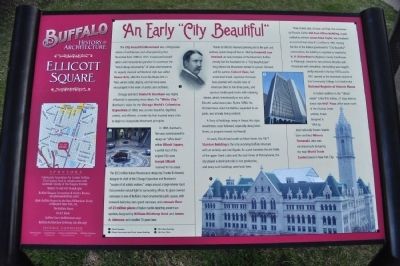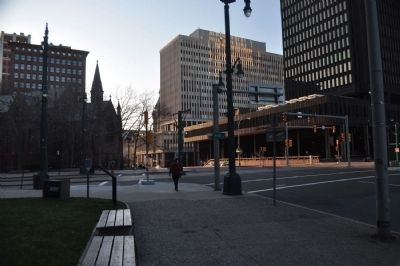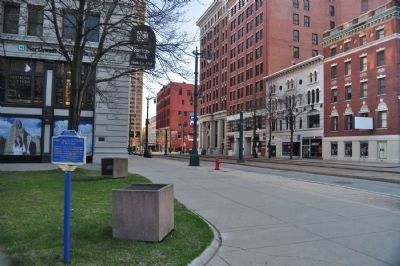Downtown in Buffalo in Erie County, New York — The American Northeast (Mid-Atlantic)
Ellicott Square
An Early "City Beautiful"
Buffalo History Architecture
The City Beautiful Movement was a Progressive reform of architecture and urban planning that flourished from 1890 to 1915. It espoused beautification and monumental grandeur to counteract the "moral decay and poverty" of urban environments. Its vaguely classical architectural style was called Beaux Arts, after the Ecole des Beaux Arts in Paris, where order dignity, and harmony were encouraged in the work of artists and architects.
Chicago architect Daniel H. Burnham was highly influential in spreading these ideals. The "White City." Burnham’s vision for the Chicago World's Columbian Exposition of 1893, was at once beautiful, dignified, orderly, and efficient, a model city that inspired many cities to begin to incorporate Movement principles.
In 1895, Bumham’s firm was commissioned to design an "office block” within Ellicott Square, a partial tract of the original 100 acres Joseph Ellicott reserved for his estate. The $3.5 million Italian Renaissance design by Charles B. Atwood, designer-in-chief of the Chicago Exposition and Bumham's ”master of all artistic matters," wraps around a large interior court that provided natural light to surrounding offices. Its glass-covered concourse is one of Buffalo's most ornamental public spaces, with ironwork balconies, twin grand staircases, and a mosaic floor of 23 million pieces of Italian marble depicting ancient sun symbols, designed by William Winthrop Kent and James A. Johnson and installed 35 years later.
Thanks to Elliott's visionary planning and to the park and parkway system designed here in 1868 by Frederick Law . Olmsted, an early champion of the Movement, Buffalo already had the foundation for a "City Beautiful plan" long before the Movement started to spread. Olmsted and his partner, Calvert Vaux, had envisioned broad, expansive thoroughfares planted with double rows of American Elms to link three parks, and spacious landscaped circles with radiating streets, which, intentionally or not, echo Elliott's radial street plan. By the 1890s the Olmsted-Vaux vision for Buffalo, expanded to six parks, was already being realized.
A flurry of buildings, many in Beaux Arts style, nevertheless soon followed, especially along Main Street, as progress moved northward.
On early Ellicott land south on Main Street, the 1877 Stanton Building is the only surviving Buffalo structure with an entirely cast-iron facade. As a port between the ore fields of the upper Great Lakes and the coal mines of Pennsylvania, the city played a dominant role in iron production, and many such buildings were built here.
Three streets east, at Swan and Oak, the monumental Flemish-Gothic Old Post
Office building, largely credited to architect James Knox Taylor, was completed at a cost of more than $1.5 million in 1901 . Among the first of the federal government's "City Beautiful" constructions, the building is regarded as inspired by H. H. Richardson's Allegheny County Courthouse in Pittsburgh. Vacant for two previous decades and threatened with demolition, the building was magnificently restored in the late 1970s and in 1981 opened as the downtown branch of Erie Community College. It is listed in the National Register of Historic Places.
A modem addition to the "Ellicott estate" is the $16 million, 21-story International style M&T Plaza office tower north of the Division Street arteries. It was designed in 1965 by internationally known Seattle-born architect Minoru Yamasaki, who was simultaneously designing the twin World Trade Center towers in New York City.
Topics. This historical marker is listed in these topic lists: Charity & Public Work • Environment • Settlements & Settlers. A significant historical year for this entry is 1890.
Location. 42° 52.964′ N, 78° 52.503′ W. Marker is in Buffalo, New York, in Erie County. It is in Downtown. Marker is at the intersection of Division Street (New York State Route 5) and Main Street, on the right when traveling east on Division Street. Touch for map. Marker is in this post office area: Buffalo NY 14202, United States of America. Touch for directions.
Other nearby markers.
At least 8 other markers are within walking distance of this marker. First Greek Settlers of Buffalo (here, next to this marker); General Kazimierz Pulaski (here, next to this marker); Ellicott Square Building (a few steps from this marker); Nikola Tesla (within shouting distance of this marker); St. Paul's Cathedral (within shouting distance of this marker); Grover Cleveland (about 300 feet away, measured in a direct line); The City of Buffalo Sent 18893 Men to Serve in the Great War (about 300 feet away); Saint Paul's Episcopal Church (about 300 feet away). Touch for a list and map of all markers in Buffalo.

circa 1905
4. Ellicott Square, Buffalo, N.Y. Largest Office Building in the World
Wikipedia on Ellicott Square:The Ellicott Square Building is an office complex in Buffalo, New York, USA. It was designed by Charles Atwood of D. H. Burnham & Company, and completed in May, 1896. At the time of its completion, it was the largest office building in the world. In 1896 and 1897, the building was the site of Edisonia Hall and the Vitascope Theater, the earliest known dedicated motion picture theater in the world….At 10 stories high – with the capacity to support 10 more floors – and 447,000 square feet (41,500 m2), the Ellicott Square Building was the largest office building in the world by floor area until 1908, with the opening of the Hudson Terminal buildings in New York City. It was built at a cost of $3.5 million in less than one year. The building was named after Joseph Ellicott, the planner and surveyor who laid out the then-village of Buffalo.
Credits. This page was last revised on February 16, 2023. It was originally submitted on June 13, 2013, by Yugoboy of Rochester, New York. This page has been viewed 622 times since then and 18 times this year. Photos: 1, 2, 3. submitted on June 13, 2013, by Yugoboy of Rochester, New York. 4. submitted on January 2, 2015. • Bill Pfingsten was the editor who published this page.


